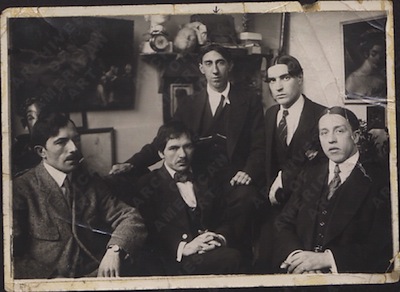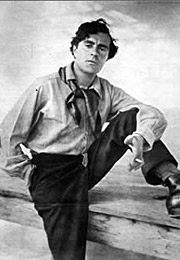


Brush and brown wash over graphite
49.5 x 32.4 cm. (19 1/2 x 12 3/4 in.)
frame: 66.5 × 49.5 × 4.5 cm (26 3/16 × 19 1/2 × 1 3/4 in.)
L.1988.62.20
Inscribed lower left: MATEO / PARIS
[Georges Chéron (d. 1931), Paris]. [Jacques Dubourg (1897–1981), Paris]. Private Collection, Paris [?]. Henry Pearlman, New York, by 1951; Henry and Rose Pearlman Foundation, by 1959.
A prolific draftsman, Modigliani made numerous sketches of his artistic colleagues. In this characteristically reductive portrait of the Spanish guitarist and sculptor Mateo Alegria, he exploited the tension between text and image: the sitter’s first name is spelled out in a stacked column of capital letters that reinforces the expressive elongation of his nose, chin, and neck.
Photograph of the subject, Mateo Alegria (center figure):


Amedeo Modigliani (1884-1920)
Modigliani lived a much-fabled life among the international avant-garde circles in early 20th-century Paris. Although he died at the age of thirty-five, Modigliani was a prolific artist, best known for his uniquely stylized paintings and drawings of friends, lovers, fellow artists, and literary figures. As a group, these works form an articulate portrait of the avant-garde centered around Montmartre at the time.
Modigliani was born in Livorno, Italy, to a middle-class Jewish family. He suffered serious illness during his youth, contracting pleurisy, which developed into tuberculosis. From his early teens he resolved to become an artist, and in 1898 he began to study with local plein air painter Guglielmo Micheli, who stressed working directly from nature. Modigliani was exposed to a wide variety of Italian art over the course of travels through his home country and received formal training in Florence (1902), followed by Venice. In January 1906, Modigliani moved to Paris, where he settled, first in Montmartre and later in Montparnasse, and attended the Académie Colarossi. Among the international coterie of young artists, Modigliani stood out in particular for his combination of personal elegance, intellectual prowess, and frail health. He experimented with different styles and influences, including the work of Henri de Toulouse-Lautrec, Picasso’s blue period, and the late portraits of Paul Cézanne.
Modigliani first turned to sculpture in 1902, and the medium became his primary focus from 1909 to 1914. He was inspired in part by meeting Constantin Brancusi, whose stylized sculptural forms, devotion to direct carving, and fierce independence all had an impact on Modigliani. He created a body of about twenty-five carved stone sculptures that focused on abstracted female heads, which vividly melded the influence of African sculpture with strains of Egyptian, Cycladic, Greek, Romanesque, and Gothic styles. Conceiving of these works as a series, he exhibited seven heads together in 1912 at the Salon d’Automne, under the title Têtes, ensemble décoratif.
Apparently due to health concerns and other practicalities, Modigliani ceased work on sculpture around 1914 and turned his focus to drawing and painting, in which the influence of his sculptural work remained indelible. He made a series of overtly erotic contemporary nudes, although portraiture was his dominant subject. Modigliani’s portraits combine abstraction and elements of caricature; his stylized faces and bodies often are surprisingly revealing in their degree of penetrating observation and psychological subtleties. His portraits captured many leading figures in the artistic and literary avant-garde, among them Jacques Lipchitz, Pablo Picasso, Diego Rivera, Chaïm Soutine, Jean Cocteau, and Max Jacob. Modigliani’s life was cut short by tubercular meningitis, and his demise was hastened by his abundant use of drugs and alcohol.